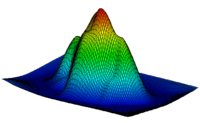|
|
| Line 12: |
Line 12: |
|
| |
|
| ==Grid → Ugrid== | | ==Grid → Ugrid== |
| A new unstructured grid can be created from a 2D grid by selecting the '''Grid → UGrid''' command from the ''Grid'' menu. The new [[GMS:UGrid Module|Ugrid]] will use the dimension of the 2D Grid.
| | Creates a new unstructured grid using the selected 2D grid. The new [[GMS:UGrid Module|Ugrid]] will use the dimension of the 2D Grid. |
|
| |
|
| ==Contours → Arcs== | | ==Contours → Arcs== |
2D Grids may be converted to other types of data used in GMS, such as a TIN, 2D mesh, or 2D scatter points. 2D Grids can be converted by using the following commands in the Grid menu:
Grid → 2D Scatter Points
The Grid → 2D Scatter Points command in the Grid menu is used to create a new scatter point set using the nodes or cells of a 2D grid. A copy is made of each of the datasets associated with the grid and the datasets are associated with the new scatter point set. A prompt will ask to name the new scatter set.
Grid → TIN
A new TIN can be created from a 2D grid by selecting the Grid → TIN command from the Grid menu. Two triangles are created from each cell in the grid.
Grid → 2D Mesh
A new 2D finite element mesh can be created from a 2D grid by selecting the Grid → 2D Mesh command from the Grid menu. A four node quadrilateral element is created from each cell in the grid. A prompt will ask to create the mesh either using the cell centroids or using the cell corners.
Grid → Ugrid
Creates a new unstructured grid using the selected 2D grid. The new Ugrid will use the dimension of the 2D Grid.
Contours → Arcs
Creates a new feature coverage containing arcs derived from the linear contours on the 2D grid. The command only works if linear contours are being displayed.
